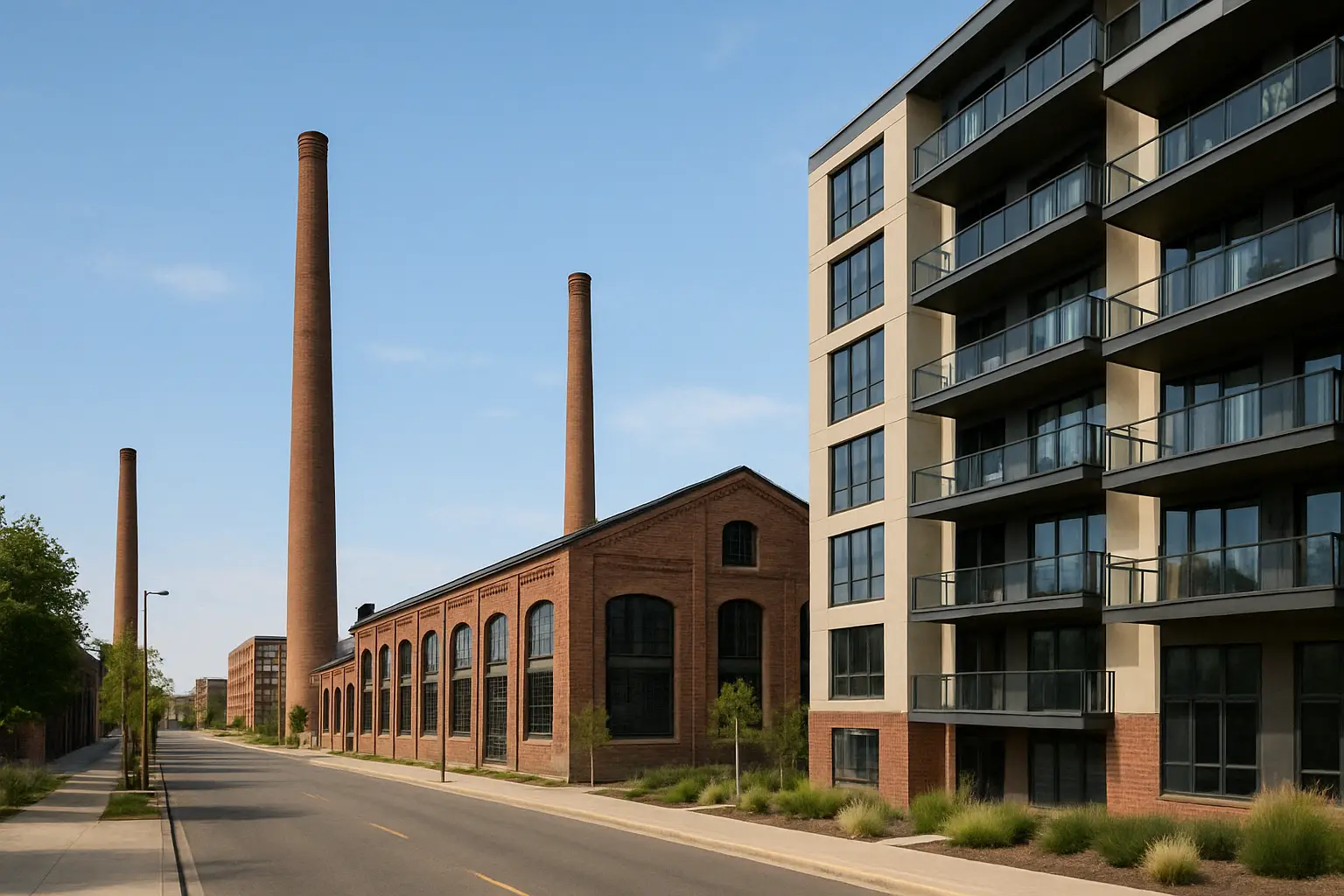As urban populations swell, revitalized industrial corridors present unique investment opportunities. These areas, often enhanced by improved transportation infrastructure, are attracting forward-thinking businesses seeking lower costs and modern facilities. Historical buildings are being transformed into vibrant mixed-use spaces, driving demand for industrial services. The question is, which markets are poised to experience the most significant growth and revitalization? Understanding these trends could position you at the forefront of this evolving environment.
The Impact of E-commerce on Industrial Real Estate Demand
As e-commerce continues to expand rapidly, it’s reshaping the terrain of industrial real estate demand in significant ways.
You’ll notice that e-commerce sales now represent 9% to 16% of total retail sales in the U.S., growing three times faster than traditional retail. For every $1 billion increase in e-commerce sales, you’ll need an additional 1.25 million square feet of warehouse space.
Given the complexities of e-commerce logistics, online retail requires three times more warehouse space than conventional models. The push for same-day delivery heightens the demand for strategically located distribution centers. Industrial real estate demand has reached unprecedented levels, emphasizing the need for modern logistics facilities to support this growth. Additionally, data analytics plays a crucial role in real-time data monitoring, enabling businesses to swiftly adapt to shifting market demands.
Consequently, modern warehouse design is evolving, with larger footprints and specialized facilities like cold storage becoming key to accommodate high-throughput operations and support omnichannel retailing.
Emerging Markets: Identifying Strategic Locations for Investment
Identifying strategic locations for investment in emerging industrial markets involves analyzing key attributes that enhance logistical efficiency and market potential.
Effective location analysis requires consideration of the following factors:
- Proximity to Transportation Infrastructure: Locations near interstates, ports, and railways boost supply chain resiliency. Additionally, the increased demand for warehouse and distribution space driven by e-commerce growth highlights the importance of these transportation links.
- Growing Labor Pools: Emerging metropolitan areas with expanding populations increase the available workforce and local demand for industrial services.
- Cost-Effectiveness: Regions with lower operational and labor costs attract businesses seeking affordable solutions.
Revitalization Strategies: Transforming Industrial Spaces for Modern Use
Transforming industrial spaces for modern use requires innovative revitalization strategies that align with current market demands and community needs. One effective approach is adaptive reuse, which creatively repurposes old buildings into residential or commercial spaces. This not only preserves historical value but also fosters community involvement by engaging local stakeholders in the planning process. Repurposed spaces provide opportunities for creative development and serve as a catalyst for attracting new businesses and artists to the area. Furthermore, utilizing smart contracts can streamline transaction processes for these revitalized properties. Urban infill projects can complement these efforts, utilizing vacant lots to integrate new developments seamlessly into existing neighborhoods. Additionally, environmental remediation addresses contamination issues, paving the way for mixed-use developments that combine retail, residential, and office spaces.
Technological Advancements Shaping the Future of Industrial Properties
The revitalization of industrial corridors not only breathes new life into old structures but also sets the stage for technological innovations that redefine how these properties function.
As you explore these advancements, consider the following key trends:
- AI Integration: AI-driven inventory management optimizes stock levels, while chatbots enhance tenant communication.
- Automation Trends: Autonomous mobile robots and forklifts streamline operations, reducing labor dependency and improving efficiency. This alignment with automation and technology integration is essential for staying competitive in the evolving market.
- Sustainability Practices: Smart technology, like IoT-connected HVAC systems and solar panels, supports energy efficiency and lowers operational costs.
Frequently Asked Questions
What Are the Risks of Investing in Revitalized Industrial Corridors?
Investing in revitalized industrial corridors exposes you to market volatility and unpredictable tenant demand. High cleanup costs, lengthy timelines, and regulatory hurdles can hinder returns, making careful analysis significant before committing to these areas.
How Do Local Regulations Affect Industrial Revitalization Projects?
Local regulations markedly impact industrial revitalization projects. Zoning laws can either restrict or promote development, while streamlined permit processes shorten timelines, lowering costs. Understanding these changes is important for successful project planning and execution.
What Financing Options Are Available for Industrial Redevelopment?
For industrial redevelopment, you can explore grant funding and private equity options. These sources provide key capital, enabling you to leverage unique project characteristics and maximize potential returns while minimizing financial risk and enhancing long-term viability.
How Can Investors Assess Community Engagement in Development Projects?
To assess community engagement in development projects, you’ll analyze community feedback and prioritize stakeholder involvement. Employ diverse data collection methods, ensuring transparency and responsiveness, which fosters trust and enhances the quality of engagement outcomes.
What Role Does Environmental Remediation Play in Property Redevelopment?
Environmental remediation techniques play a key role in addressing contamination, minimizing environmental impact and enabling property redevelopment. By restoring safety and value, you attract investment, foster community trust, and promote sustainable growth in revitalized neighborhoods, ultimately enhancing economic prospects.
References
- https://www.ioptimizerealty.com/blog/2024-mid-year-outlook-industrial-real-estate-market-report
- https://www.tylercauble.com/blog/industrial-real-estate-trends-2024
- https://blog.transactly.com/building-the-future-infrastructures-impact-real-estate-values
- https://montrose-env.com/blog/strategies-to-revitalize-americas-abandoned-properties-and-legacy-neighborhoods/
- https://nacto.org/wp-content/uploads/Reconstructing-the-commercial-strip_ICFinternational.pdf
- https://www.cbre.com/insights/briefs/ecommerces-impact-on-industrial-real-estate-demand
- https://www.areswms.com/accessares/fast-take/impact-e-commerce-industrial-real-estate
- https://www.prologis.com/insights/global-insights-research/e-commerce-boom-isnt-over-implications-logistics-real-estate
- https://www.vhb.com/viewpoints/whitepapers/ecommerce-growth-and-industrial-space-demand/
- https://www.paliseproperty.com/blog/ecommerce-is-transforming-industrial-real-estate-in-2024

